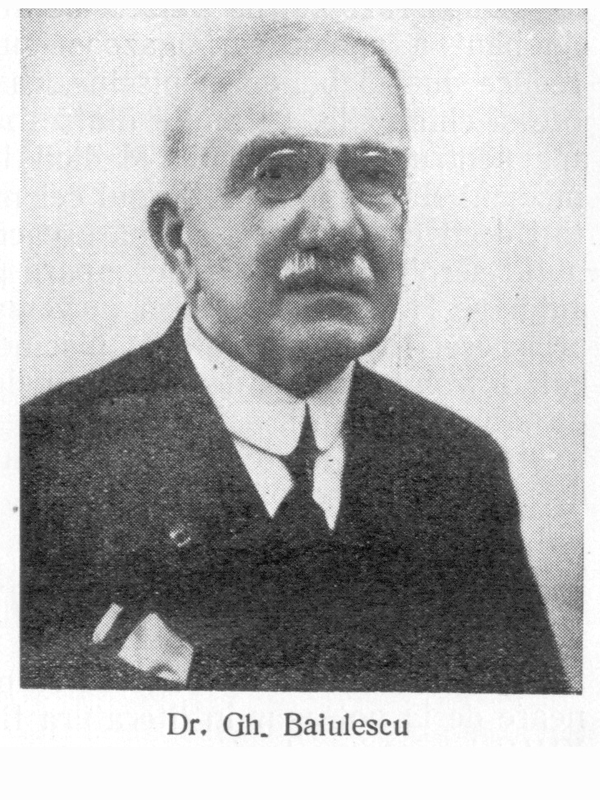Senior State Official and Deputy Ferdinand Conrad Johann Voith von Sterbez (1813–1882)
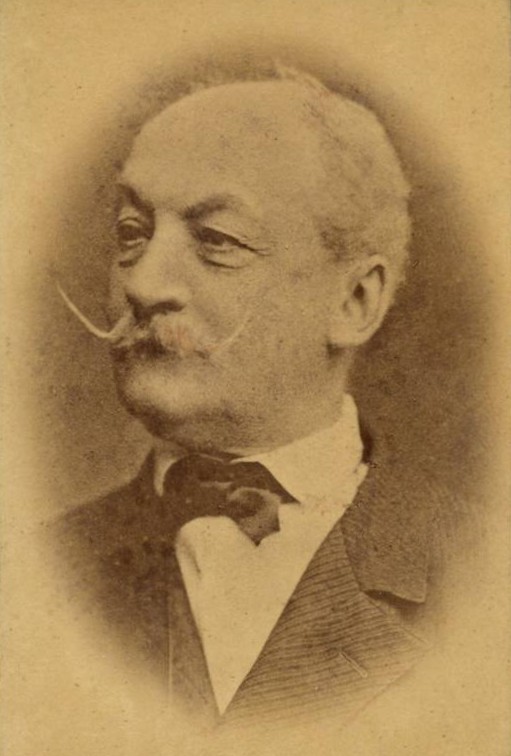
Ferdinand baron Voith von Sterbez
“[…] You have conquered the hearts of all the citizens […] by Your noble efforts and deeds. What wonder, therefore, that on this momentous day, when Your Eminence celebrates the precious feast of Your forty years of public service, the hearts of our fellow citizens, who have been privileged to witness Your beneficent work in the field of public administration […], rejoice.” These are the words of an official letter of congratulation addressed to Ferdinand Voith von Sterbez by the town council of Německý Brod (today Havlíčkův Brod / Deutschbrod) in 1875. Ferdinand Voith had been an exemplary civil servant, who managed to be popular among both his superiors and subordinates. He dedicated all his life to public service as a district captain, a member of parliament and a public figure.
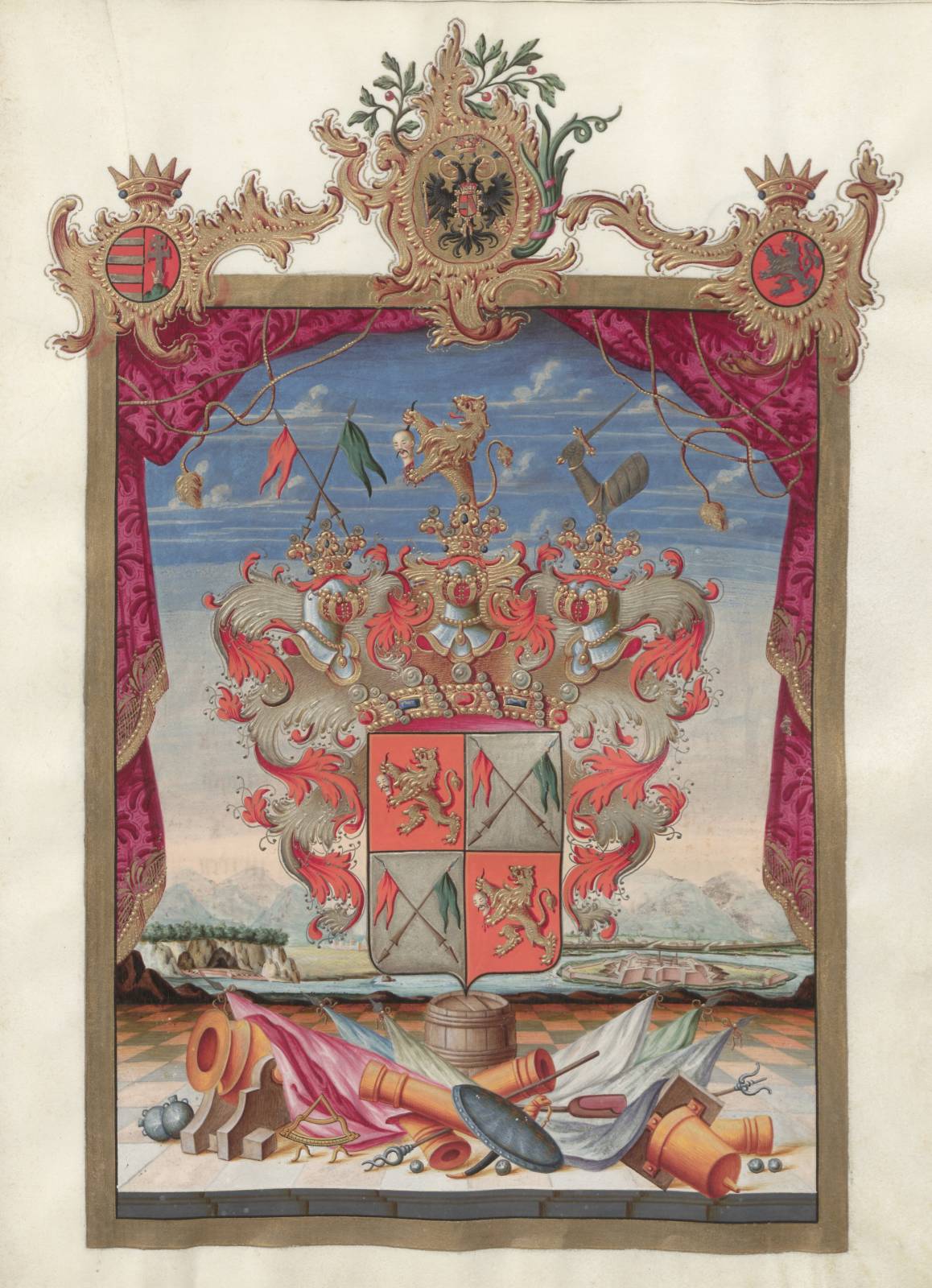
Coat of arms of the Voith von Sterbez family. SOkA Kutná Hora, fonds Ferdinand Voith von Sterbez, box 3, call number 55.
Ferdinand’s grandfather Johann von Voith (1746–1831) was an imperial officer and so was Ferdinand’s father Vincenz (1785–1845). However, after several years in the army Vincenz decided to leave and he became a hereditary postmaster. This was a prestigious position in the nineteenth century. Vincenz got this position because of his marriage to Theresia Kocy (1790–1838), whose father had held the post before him.
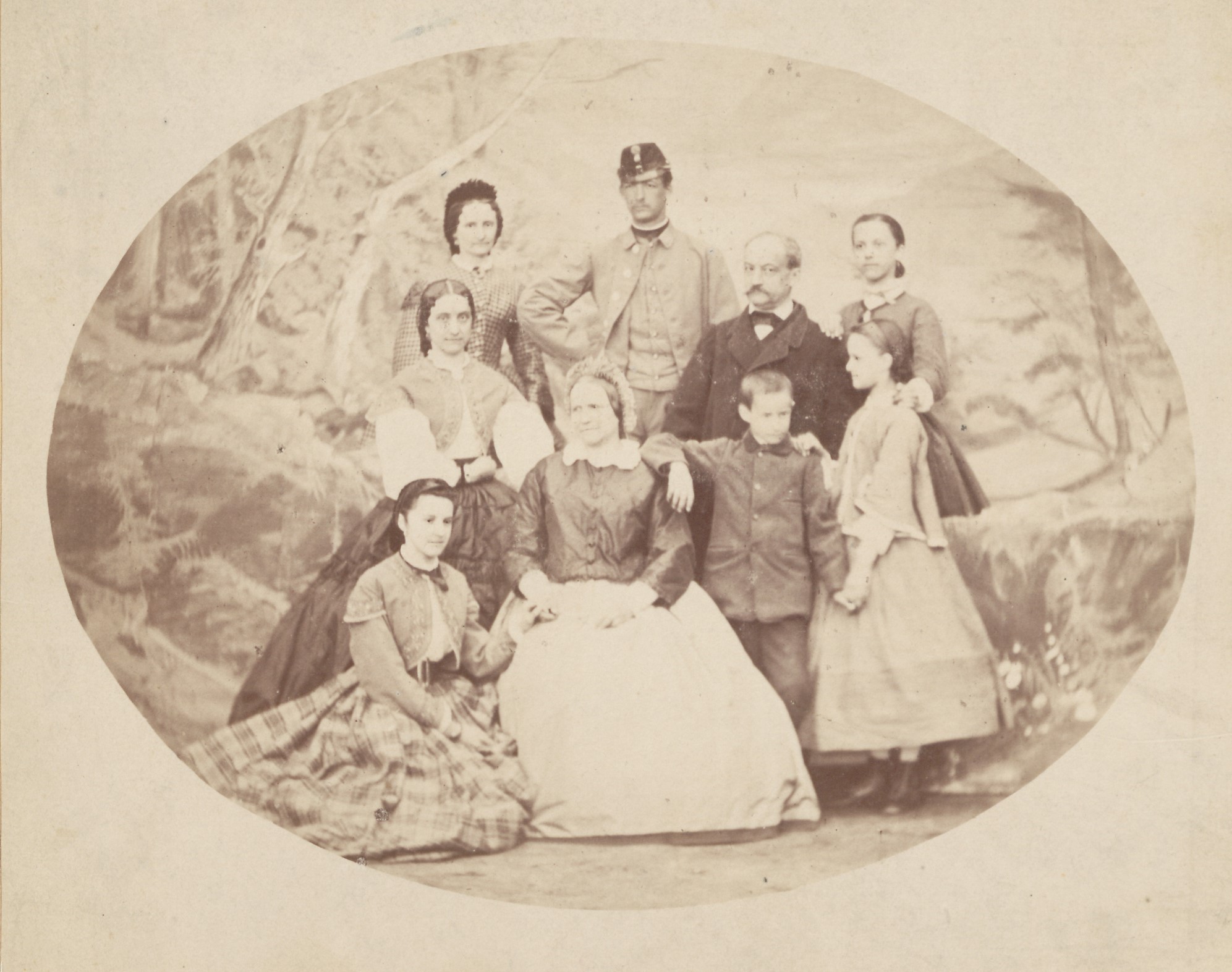
Family of Ferdinand Voith von Sterbez. SOkA Kutná Hora, fonds Ferdinand Voith von Sterbez, box 3, call number 40.
Vincenz and Theresia were married for more than 30 years, but they had only one son – Ferdinand Conrad Johann, who was born on May 20, 1813, in Německý Brod. In this town Ferdinand also attended grammar school and probably had an opportunity to learn more about the Czech national revival. Karel Havlíček Borovský (1821–1856), a journalist and important personality for the Czech emancipation movement, went to this school as well, but at this point Ferdinand and Karel did not meet. After finishing secondary education, Ferdinand studied law in Prague, which was an essential prerequisite for his future in the state administration.
His first job was at the Land Governor’s Office in Prague as a trainee official. This stage of F. Voith’s career did not last very long, since he passed an exam and became a trainee official the following year. At this point of his career, he still did not receive any salary, but that did not prevent him from getting married and starting a family. In 1837 he married Maria Anna Theresia (1816–1885), daughter of Baron Johann Matzner von Herites (1769–1841).
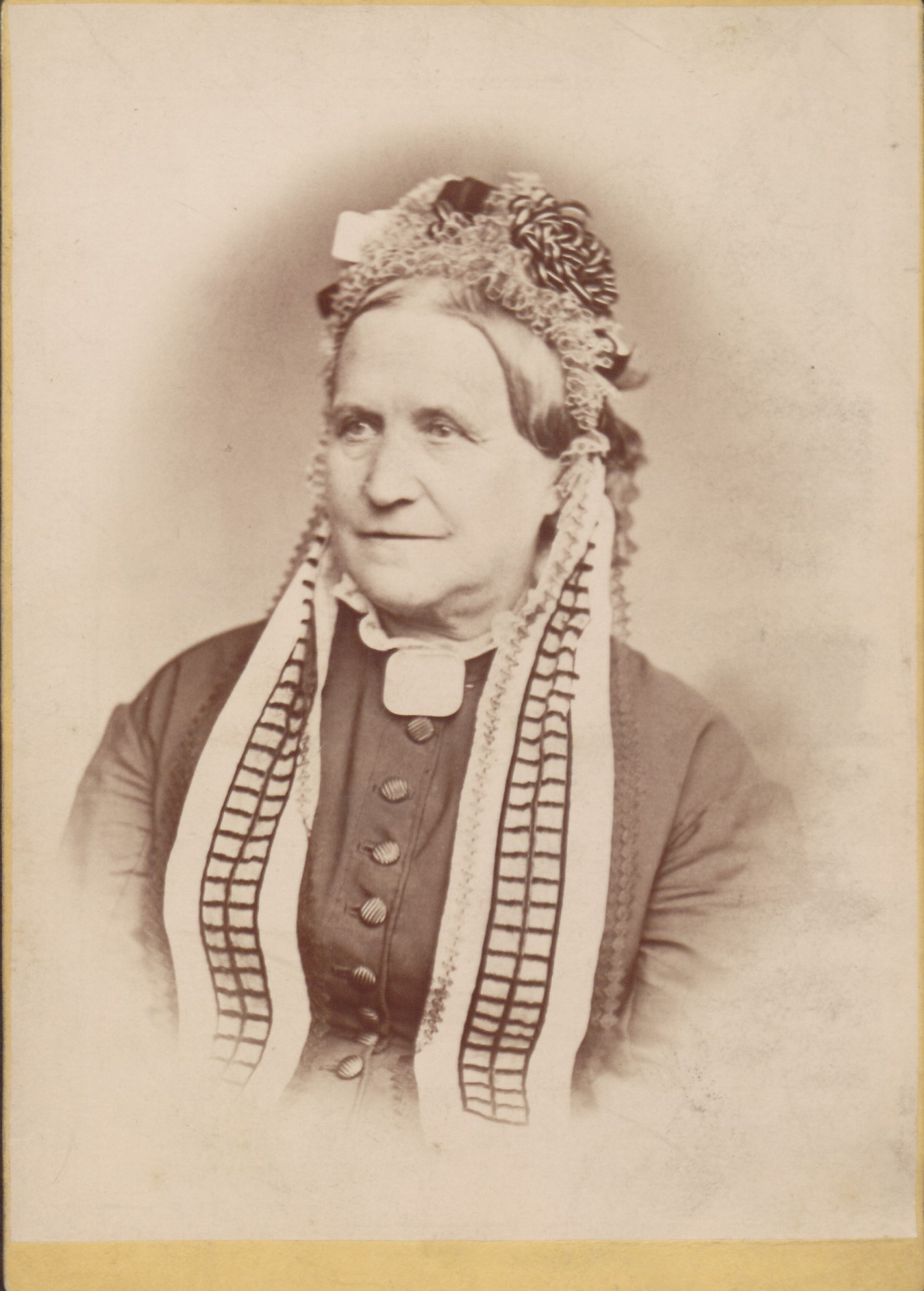
Maria Voith von Sterbez born von Herites. SOkA Kutná Hora, fonds Ferdinand Voith von Sterbez, box 3, call number 39.
It was only in October 1849, when Ferdinand finally began receiving an adequate salary for his work. In 1868, after working in a few more Bohemian towns, he reached the position of a district captain at the District Captainship in Čáslav and kept this post until his death. The first years of marriage must have been difficult for both Ferdinand and his wife. They had ten children, who were born in four different towns. Four children died before they became adults. The financial situation of the family was not satisfactory either. Ferdinand had to borrow money repeatedly, but, fortunately, due to his status, there were always enough creditors willing to help him out.
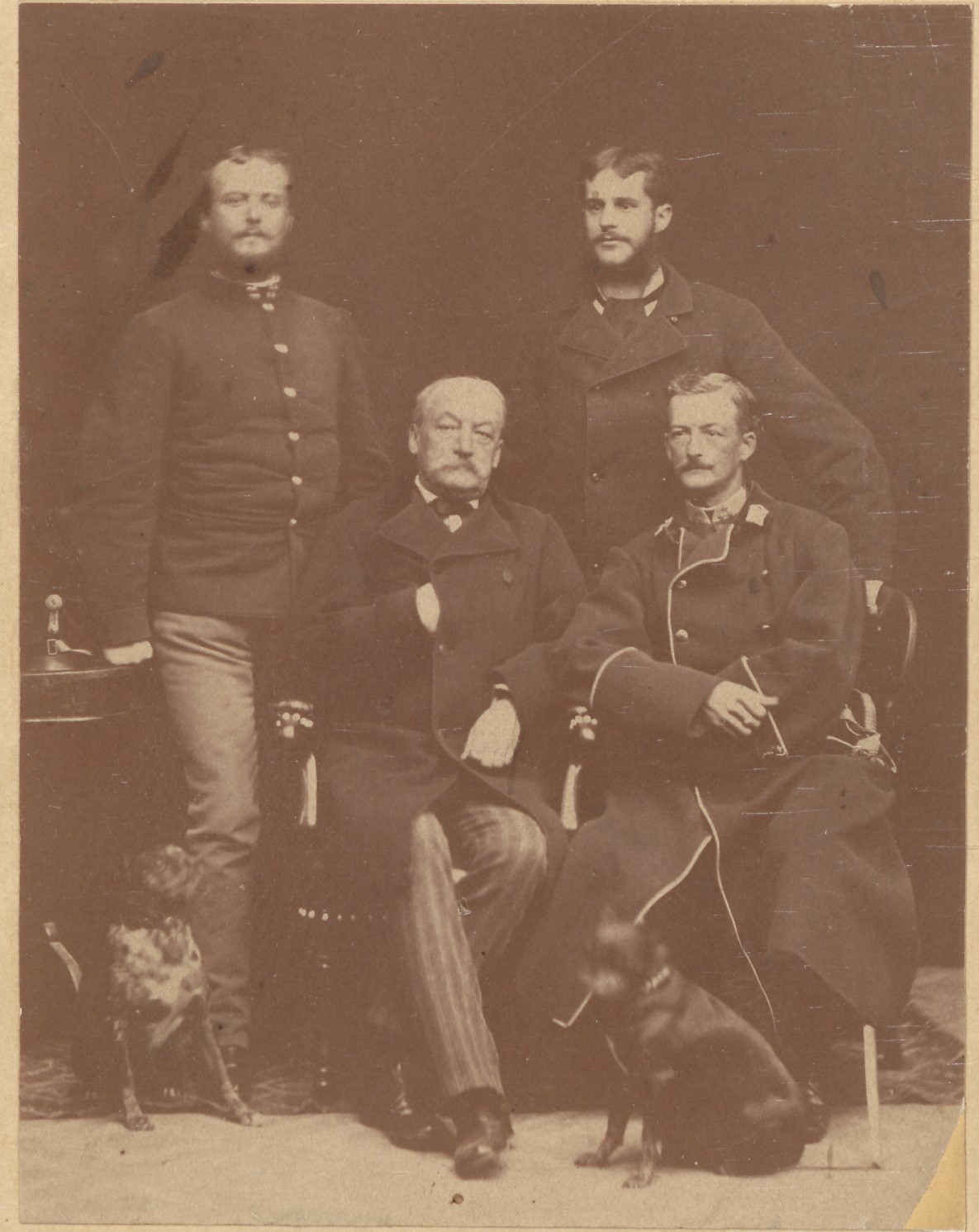
Ferdinand Voith von Sterbez and his sons. SOkA Kutná Hora, fonds Ferdinand Voith von Sterbez, box 3, call number 42.
Ferdinand Voith von Sterbez served the Austrian state at the time when the authorities were supposed to oppress any kind of anti-government resistance. The difficulties of his position within the system may be best demonstrated in his relationship with Karel Havlíček Borovský, who was constantly critical of the Austrian government. For his public comments he was arrested in December 1851 and Ferdinand, as a representative of the local administration, was present during this arrest. Later on, Ferdinand’s daughters claimed that their father tried to warn Karel, but there is no proof for this. It is clear that Ferdinand helped Karel, when the journalist was in exile in Brixen, but Ferdinand never forgot that he was first and foremost a civil servant, who served the Austrian state.
When Ferdinand’s position in the state administration was stable, he entered another public sphere – politics. In 1861 he became a deputy in the Bohemian Diet for the curia of rural communities. Ferdinand was obviously popular among village mayors, who formed a significant part of the electorate. During his six years in the diet, he usually endorsed bills which limited the power of large estate owners and supported the rights of all nations to rule their own things within the monarchy. In the 1860s, the involvement of civil servants in politics was accepted and even welcomed by the authorities. The obvious conflict of interests did not represent a problem. This changed in the 1880s, when the government prohibited state officials from entering politics in order to secure their neutrality.
As mentioned before, Ferdinand and Maria had ten children together, but four of them did not survive their childhood. The oldest daughter Maria (1838–1900) got married twice. Her first husband was Philip von Behacker (1809–1884), a Court Secretary, and her second husband was Jan Němeček (1837–1908), a bank clerk. Her younger sisters Bertha (1844–1920) and Hermine (1851–1921) never married and spent their lives living together in Kolín. As they were not in a position to earn their own salary, they lived on their parents’ inheritance. The oldest son Vincenz (1842–1912) embarked on a military career and achieved the rank of major. The second oldest son Rudolf (1848–1905) join the army as well and became a captain. He married Anna Maria Tiegel von Lindenkron (1862–1929), the heiress of the estate of Osečany. The youngest son Ferdinand (1856–1885) started to study at Technical College Prague but died of tuberculosis at the age of 29.
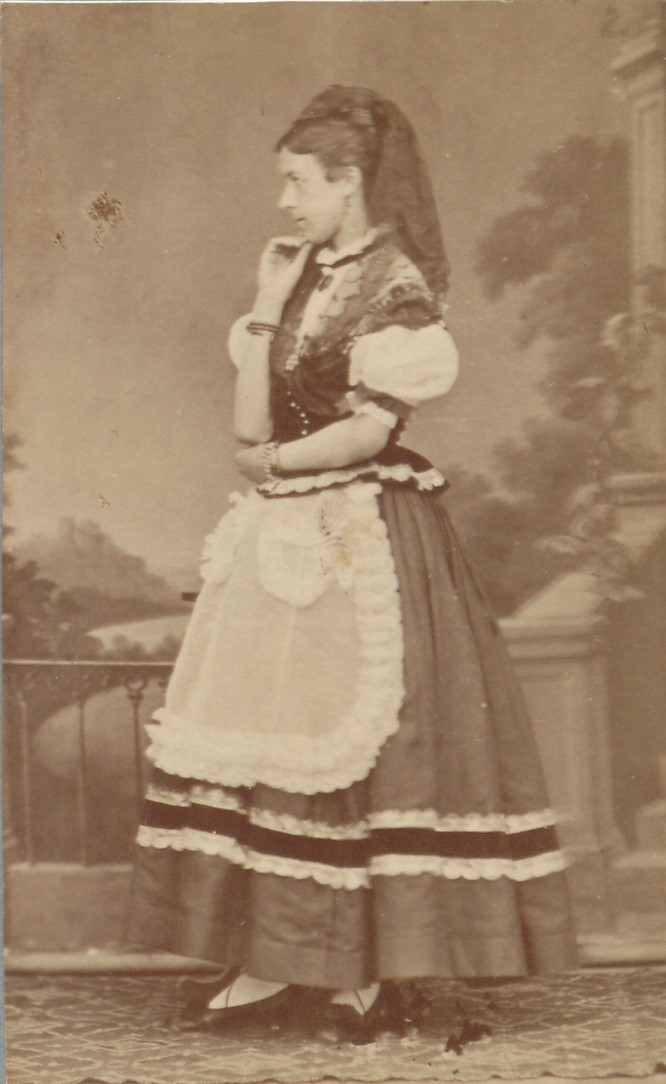
Hermina Voith von Sterbez. SOkA Kutná Hora, fonds Ferdinand Voith von Sterbez, box 3, call number 44.

Berta Voith von Sterbez. SOkA Kutná Hora, fonds Ferdinand Voith von Sterbez, box 3, call number 44.
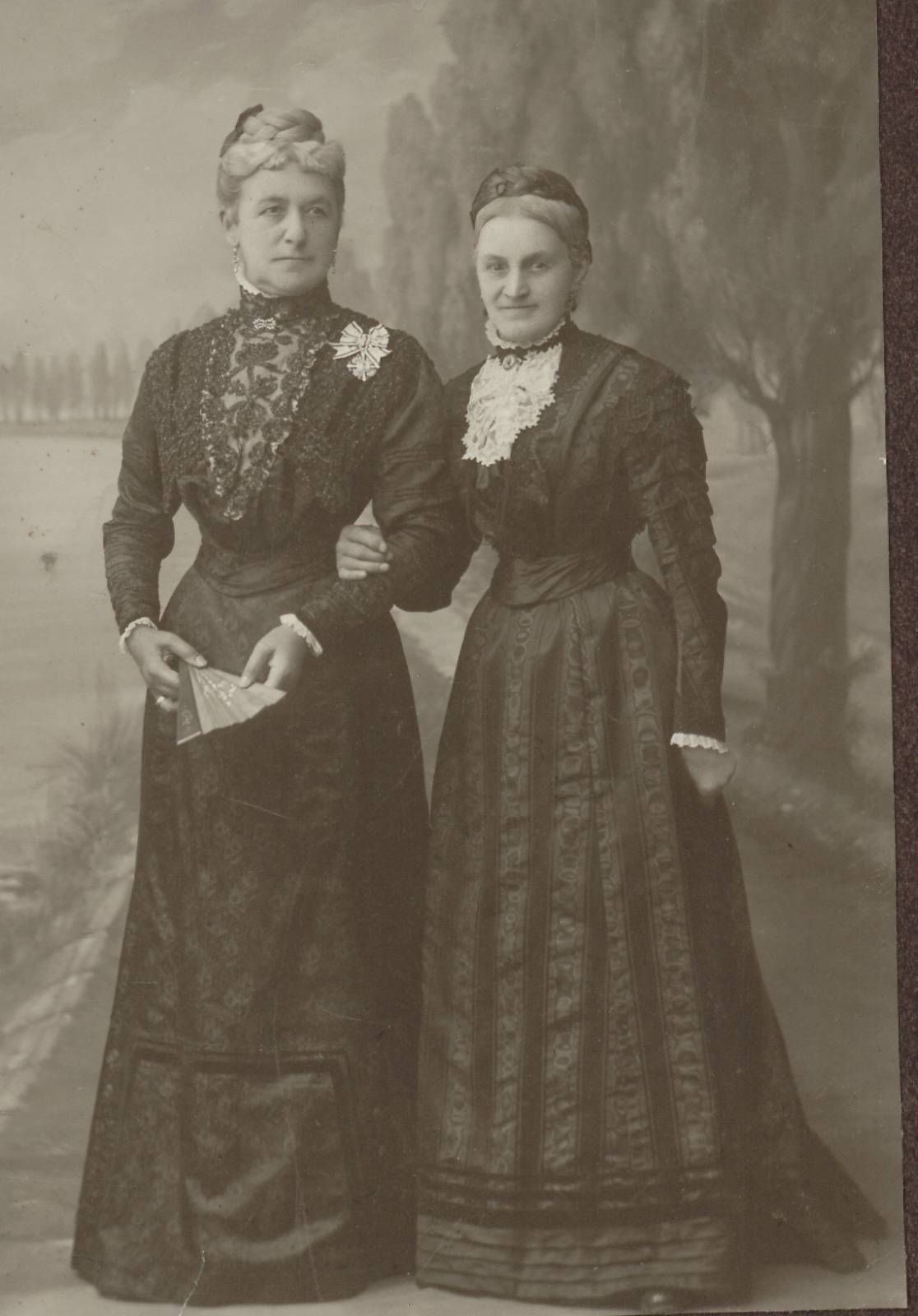
Hermina and Berta Voith von Sterbez. SOkA Kutná Hora, fonds Ferdinand Voith von Sterbez, box 3, call number 45.
Ferdinand Voith von Sterbez died on 10 February 1882 in Čáslav, a town, which became his destiny. His creditor Vojtěch Weidenhoffer (1826–1901) noted in his diary on this day: “This evening Mr Ferdinand Baron Voith von Sterbez, a Junior Governor’s Office Councillor and honorary burgher of this town, passed away. He was a meritorious and much respected and admired man. May God grant him a peaceful rest.” The funeral was a huge event attended by thousands of people, which was without any doubt a manifestation of F. Voith’s importance for the local community.
Although Ferdinand came from a noble family, his ancestors did not belong to old aristocracy and did not secure a stable income for him and his children. Ferdinand’s origin might have been useful at the beginning of his career, but later it was mostly his skills and diligence, which helped him to succeed. Unfortunately, this was not enough to provide sufficient inheritance for his children. Ferdinand felt sympathy for the Czech national revival, but he was never disloyal to his employer – the Austrian state.
Archival Sources
Státní okresní archiv Kutná Hora (State District Archives Kutná Hora, SDA Kutná Hora), fonds Voith von Sterbez Fedinand.
Bibliography
Karásek ze Lvovic, Jiří. O „muži, jenž zatýkal Havlíčka“. Z materiálu ke vzpomínkám Jiřího Karáska ze Lvovic [About “the Man who Arrested Havlíček”. From Materials about the Memories of Jiří Karásek ze Lvovic]. Literární rozhledy XIII, no. 9, June and July 1929: 61–62.
Kazbunda, Karel. Karel Havlíček Borovský. Svazek 1. 1821 – revoluční události 1848 [Karel Havlíček Borovský. Volume 1. 1821 – Revolutionary Events of 1848]. Praha: Ministerstvo vnitra České republiky, Odbor archivní správy a spisové služby, 2013.
Kazbunda, Karel. Karel Havlíček Borovský. Svazek 2. Ústavní oktroj 1849 – konfinování 1851 [Karel Havlíček Borovský. Volume 2. Constitution of 1849 – Expulsion 1851]. Praha: Ministerstvo vnitra České republiky, Odbor archivní správy a spisové služby, 2013.
Kazbunda, Karel. Karel Havlíček Borovský. Svazek 3. Brixen, Doma [Karel Havlíček Borovský. Volume 3. Brixen, Home]. Praha: Ministerstvo vnitra České republiky, Odbor archivní správy a spisové služby, 2013.
Klečacký, Martin. “Císařský úředník a politická strana” [An Imperial Official and a Political Party]. In Úředník sluhou mnoha pánů? Nacionalizace a politizace veřejné správy ve střední Evropě 1848–1948 [The official as the Servant of Many Masters? Nationalisation and Politisation of Public Administration in Central Europe 1848–1948]. Edited by Martin Klečacký. Praha: Centrum středoevropských studií, společné pracoviště CEVRO Institutu, z.ú. a Masarykova ústavu a Archivu AV ČR, v.v.i., 2018: 43–58.
Klečacký, Martin. Poslušný vládce okresu. Okresní hejtman a proměny státní moci v Čechách v letech 1868–1938 [Obedient Master of the District: District Captain and Changes in State Power in Bohemia in the Years 1868–1938]. Praha: Nakladatelství Lidové noviny, 2021.
Tomek, Václav Vladivoj. Paměti z mého žiwota. Díl II [Memories from My Personal Life. Part II]. Praha: W kommissi u Františka Řiwnáče, 1905.
Vaněčková, Jana. Voith von Sterbez Ferdinand. Osobní fond (1730) 1813–1882 (1944) [Voith von Sterbez Ferdinand. Personal Fonds (1730) 1813–1882 (1944)]. Inventory of the State District Archives Kutná Hora. Kutná Hora 2011.
Weidenhoffer, Vojtěch. Deník: 1861–1899 [Diary. 1861–1899]. Ed. Michal Kamp. Havlíčkův Brod: Muzeum Vysočiny, 2012.
O předcích zemského a říšského mladočeského poslance JUDr. Eduarda Brzoráda. Děje rodů von Herites, von Krziwanek, Delorme a Brzorád. [https://www.opredcich.cz/Herites.htm]
Kamila Kaizlová was born in Správčice in eastern Bohemia (today part of Hradec Králové) into the family of an affluent farmer, Adolf Píša (1825–1880).1 Soon after her 20th birthday she moved with her mother Anna (née Böhm) (1829–1896) to what is now the Smetana embankment in Prague.2 Living in Prague allowed her to establish social contacts and even a romantic relationship with Professor Josef Kaizl (1854–1901), 17 years her senior, who was then active as a Young-Czech deputy in the Imperial Council in Vienna. In the 1870s, Josef Kaizl graduated as a lawyer from the Charles-Ferdinand University in Prague, where he also started to give lectures on economics in 1879. In 1888 he was appointed full professor there, which was an important social position allowing him to consider starting a family. Kaizl and Kamila Píšová had met as early as 1889, but they got engaged only in August 1892 in Gossensaβ in Tyrol3 and eventually married in February 1893, when Josef was 38 and Kamila 21 years old. They had two daughters during their eight-year-long marriage: first-born Kamila (1895–1907) and younger Zdenka (1899–1952). Both their daughters were already born in Vienna, where the family had moved. In Vienna, Josef Kaizl managed to acquire a prominent position on the career ladder when in the spring of 1898 he was rather unexpectedly appointed as Finance Minister in the Cisleithanian government led by Franz Thun-Hohenstein (1847–1916). Kaizl held this position for only a year and half since in autumn 1899 the prime minister resigned. At that time, Josef Kaizl had less than two more years to live. After he suddenly died due to stomach ulcer complications, Kamila Kaizlová became a widow at the age of 30.4
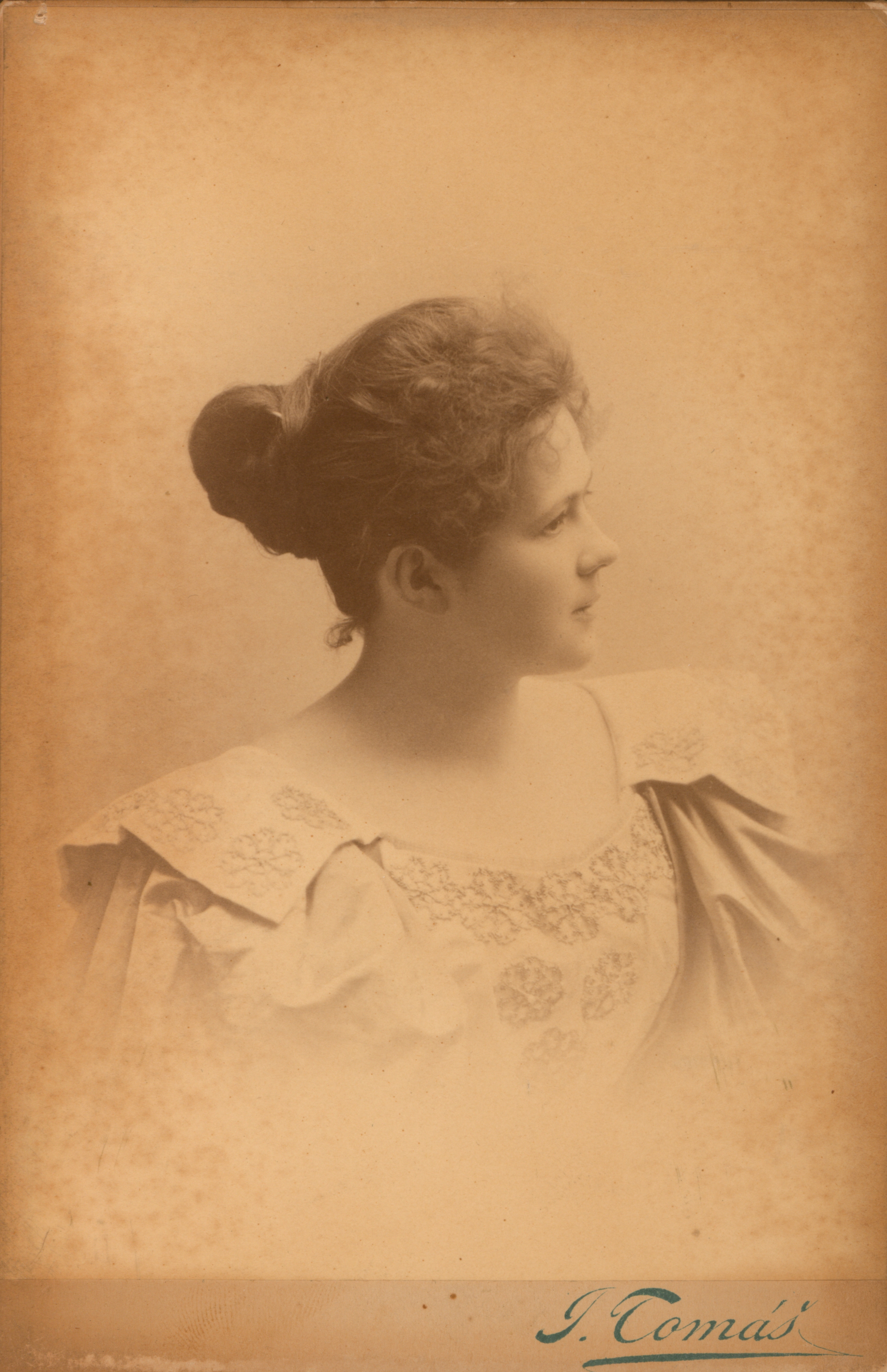 Kamila Preissová-Kaizlová, undated (Masaryk Institute and Archives of the CAS, v.v.i., fond Josef Kaizl (unarranged)).
Kamila Preissová-Kaizlová, undated (Masaryk Institute and Archives of the CAS, v.v.i., fond Josef Kaizl (unarranged)).
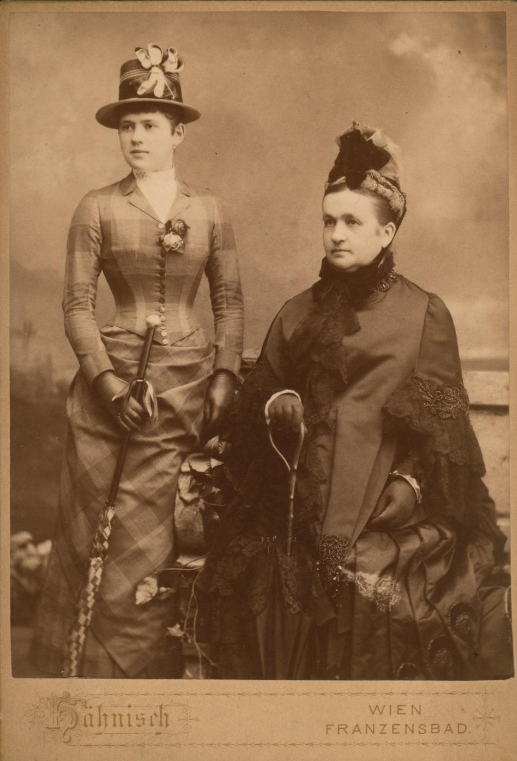
Kamila Pišová with her mother Anna Pišová in the early 1890s (Masaryk Institute and Archives of the CAS, v.v.i., fond Josef Kaizl (unarranged)).
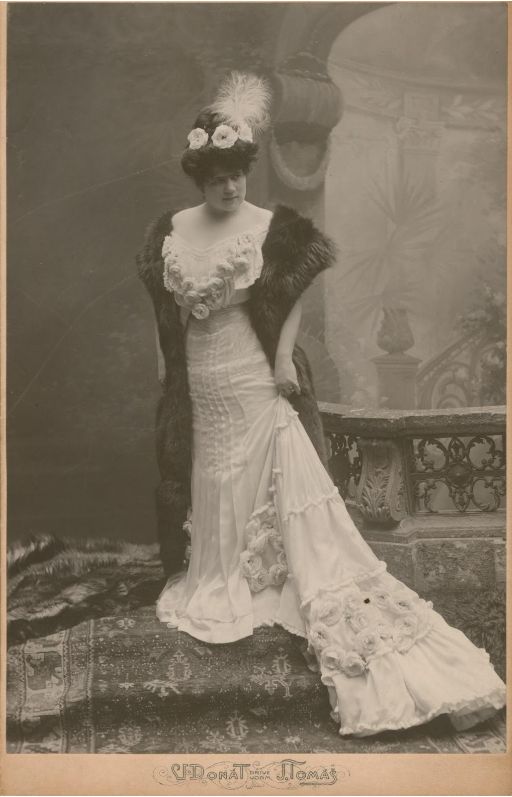
Kamila Kaizlová in a wedding dress in February 1893 (Masaryk Institute and Archives of the CAS, v.v.i., fond Josef Kaizl (unarranged)).
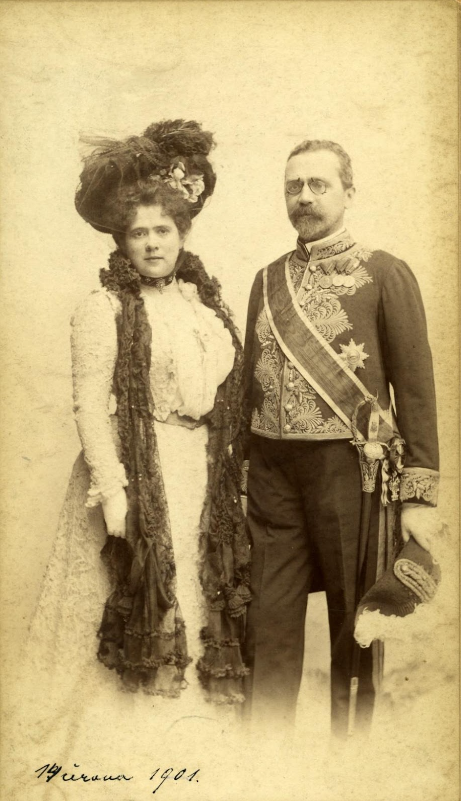
Kamila and Josef Kaizl, June 1901 (Masaryk Institute and Archives of the CAS, v.v.i., fond Josef Kaizl (unarranged)).
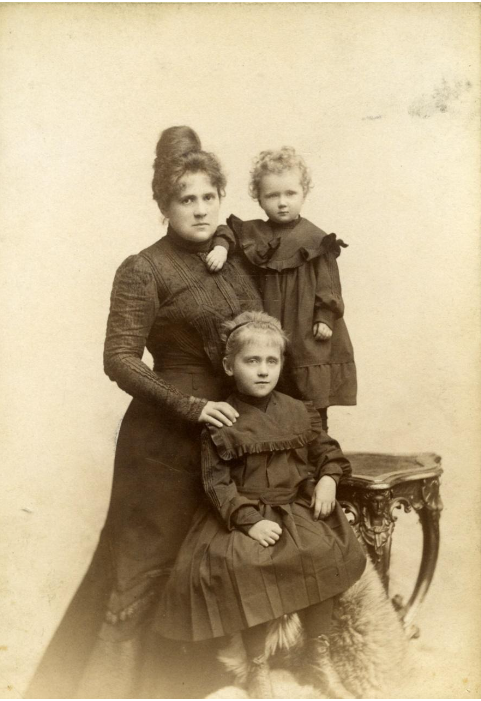
Kamila Kaizlová with her daughters after her husband's death, September 1901 (Masaryk Institute and Archives of the CAS, v.v.i., fond Josef Kaizl (unarranged)).
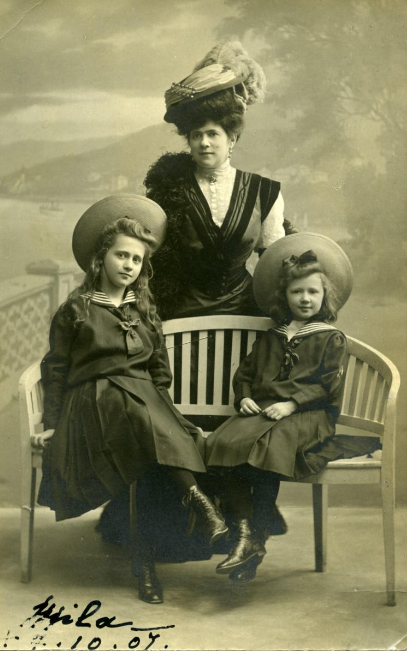
Kamila Kaizlová with her daughters, October 1907 (Masaryk Institute and Archives of the CAS, v.v.i., fond Josef Kaizl (unarranged)).
After her husband died Kamila Kaizlová moved from their apartment in the Prague Vinohrady neighbourhood back to Smetana embankment.5 The centrally located flat probably suited her better since one year after her husband’s death she took a rather unorthodox step: she started attending lectures at university. For several reasons, this decision of hers caused a minor sensation in the Prague society. There were not many women in the university lecture halls in the first place, let alone a widow of a distinguished politician looking after two young children. But a more serious reason, causing concern among many an active politician, was the alleged motivation of the ministerial widow. It was rumoured that Kamila Kaizlová was trying to improve her education so that she would be able to sort out and later publish the memoirs of her late husband. It was feared, as the Pilsner Tagblatt newspaper did not hesitate to express, that the “memoirs would contain the actual reasons behind the fall of the Count of Thun and would provide information on the intentions of Kaizl’s politics”.6 Kamila Kaizlová, the newspaper alleged, was to have obtained a special permission from the rector, enabling her to attend lectures on economics, i.e. exactly the same subject that her husband specialized in. In an interview reprinted in the Národní listy, Kaizl’s widow dismissed those speculations: “It is true that I have enrolled as an extraordinary student at the Philosophical Faculty of the Czech university; for instance last year I attended for two hours a week, this year I dedicate eleven hours a week to lectures on art, literature and history. I do not attend any societies, and therefore, this study is my occupation.” As for the publication of the memoirs, she continued: “Such conjectures are ridiculous! You have heard that I do not attend any lectures on political subjects. My husband did leave notes, but no memoirs. To publish them now would be premature since most of the persons mentioned there are still alive. It might perhaps later be possible to publish them as a contribution to recent history. It is not up to me, however, to undertake this task, since I do not have the necessary political knowledge, but up to a professional politician. I did not interfere with politics while my husband was still alive, neither will I do so now, after his death.”7 Even the Plzeňské listy denied the original information brought by the Pilsner Tagblatt.8 It was Zdeněk V. Tobolka (1874–1951) who eventually started to publish Kaizl’s diaries and correspondence in 1908.9
By coincidence, at that time Kamila Kaizlová’s name frequently appeared in articles in both Czech and German newspapers. Given that Kamila became widowed at a young age, it was to be expected that she would not live without a stable relationship forever. In 1908 she got engaged to Fedor Gyrgiewicz, 13 years her junior, lieutenant of the 13th Dragoon Regiment, allegedly an illegitimate son of the late Serbian king Milan I. Obrenovic (1854–1901).10 Accompanied by her fiancé, on Saturday 11 July 1908 Kamila attended the so-called flower parade, with horse-drawn carriages decorated with flowers passing through the streets of Prague. The parade, which attracted around thirty thousand spectators, eventually reached the exhibition area in the Royal enclosure where a tragedy occurred. The horse that was pulling the carriage driven by none other than F. Gyrgiewicz, where his fiancée was also seated, bolted. As a result, the reins got torn, the shaft broke and the whole carriage keeled over. The frightened horse threw itself onto the crowd of onlookers, causing a tragedy with one person dead and 18 gravely injured (Kamila Kaizlová herself got away unscathed). The one victim, moreover, was Jindřiška Slavínská (1843–1908), a popular former actress of the National Theatre.11 The Illustrierte Kronen Zeitung on that occasion could not suppress the fact that both the actress’s father, the writer Ludvík Ritter of Rittersberg (1809–1858), as well as her grandfather, Johann Ritter of Rittersberg (1780–1841), had died in accidents involving horses.12 During the criminal proceedings that followed F. Gyrgiewicz was eventually found not-guilty,13 but several days after the unfortunate incident he cancelled his engagement to Kamila.14
The young widow, however, did not remain alone for long. Again, she established a relationship with a man much younger than herself, Richard Preiss (1882–1967), son of the writer Gabriela Preissová (1862–1946). Richard Preiss had just freshly graduated from the Faculty od Law of the Czech Charles-Ferdinand University and worked as a trainee at the Czech Financial Prosecutor’s office.15 Their relationship eventually led to marriage, with the wedding taking place in late June 1910 in Baška on the Croatian island of Krk. However, the more than ten-year age difference between the two spouses probably resulted in a rather tumultuous relationship, and in September 1910, a mere three months after their wedding, newspapers brought the news of Kamila Preissová-Kaizlová applying for divorce “from bed and board”, which was granted by the Prague district court on 28 October 1910.16 The separation between the two spouses, however, was not yet complete since in line with the current law divorce was only the first step needed to dissolve the marriage. Even after they divorced, Richard Preiss occasionally visited Kamila, as transpires from the diaries kept by her younger daughter Zdenka.17 Sadly, not even the birth of their daughter Adriena (1914–2009), not long after World War I broke out, could bring the couple closer together. In the end, after the separation became definitive, Richard Preiss remarried, this time at a civil ceremony, taking for his wife Marie Menčíková-Trnková (1888–after 1952), who was also previously separated. But even this marriage broke up in 1932. Soon after, Richard Preiss, who at that time worked as a lawyer in Strážnice, married for the third time, taking for his wife Věra Ploskalová (1907–1995), 25 years his junior, the daughter of a citizens’ savings bank director in Hodonín. Kamila Preissová-Kaizlová did not live to see that third wedding since in April 1930 she died of chronic nephrosclerosis, making it possible for her ex-husband to have a church wedding.
Kamila Preissová-Kaizlová spent the years after divorcing her second husband in the company of her two daughters, Zdenka and Adriena – the eldest, Kamila, having died already in 1907, not yet twelve years old, of a serious pneumonia. She lived on a pension awarded to her after her first husband’s death, which she was able to keep even after she remarried. Immediately after Kaizl’s death the pension amounted to 6,000 crowns a year, with her children receiving another 1,200 crowns a year. After the birth of Czechoslovakia the amount remained unchanged, despite the war inflation, until 1928, when upon request by President Masaryk it was raised to 18,000 Czech crowns.18 However, since Kamila came from an affluent family, she was also paid interest on her own property, which, based on records from 1926, allowed her to maintain a fully equipped four-room apartment and employ a maid-servant.19
By then Kamila Preissová-Kaizlová lived only with her youngest daughter Adriena. Her daughter Zdenka moved out of the Smíchov apartment late in 1921, when she married Professor Josef Blahož (1888–1934), a consul at the Ministry of Foreign Affairs and a former officer of the Legion in Russia.20 In 1925–1931 Josef Blahož worked as counsellor at the Czechoslovak Embassy in Berlin, where the spouses maintained a lively social life and established close contact, among others, with the family of the German diplomat Ernst von Weizsäcker (1882–1951), father of the future German President, Richard von Weizsäcker (1920–2015). At one point in time, Kamila herself considered leaving for Berlin and joining her daughter’s family there.21 But in November 1921 she was hospitalized with apoplexy at a sanatorium in Santoška in Prague and spent the last months of her life worrying about the future of her fifteen-year-old daughter Adriena. At that time, Adriena stayed alternately with her father and her grandmother, Gabriela Preissová, and following their mother’s death, Zdena Blahožová also joined in taking care of her half-sister. In 1935 Adriena decided to move permanently to the USA where her father’s sister Gabriela (1892–1981) lived, married to Charles Edward Proshek (1893–1957), medical doctor and Czechoslovak consul in Minneapolis in Minnesota. Adriena never came back to Czechoslovakia.22
Even though Kamila Kaizlová spent only a lesser part of her life beside Josef Kaizl, who undoubtedly belonged among elite Czech politicians, her social position was firmly grounded in her marriage to him and she could draw from it until her last days. She maintained contacts with top Czechoslovak politicians – including Karel Kramář and T.G. Masaryk – and managed to marry her daughter Zdenka into those circles. The press called her Your Excellency and her name was usually followed by the words „widow of the Finance Minister“, even after she remarried and divorced again.
1 State regional archives in Hradec Králové, Collection of registers of the Eastern Bohemian Region, Parish of the Roman-Catholic church in Pouchov, sign. 134-7662, p. 601.
2 They lived in house No. 334 on what then was called Franz embankment (today Smetana embankment, n.334/4): National archives, Police directorate I, residence permit applications, carton 464, picture 885.
3 Zdeněk V. Tobolka (ed.), JUDr. Jos. Kaizl: Z mého života III/1., Praha 1915, p. 56.
4 Kaizl’s illness and death are described in detail by Zdeněk Tobolka: Zdeněk V. Tobolka (ed.), JUDr. Jos. Kaizl: Z mého života III/2., Praha 1915, p. 1180–1181.
5 In the last years of Kaizl’s life the family lived in Italská street, No 1219/2. After becoming a widow Kamila moved to Smetana embankment No 1012/2: National Archives, Police directorate I, residence permit applications, carton 247, picture 59; National Archives, Police directorate I, residence permit applications, carton 247, picture 58.
6 „Die Memoaren werden auch die wahren Ursachen für den Sturz des Grafen Thun enthalten und ebenso Aufschlüsse über die Intentionen der Politik Kaizls geben.“ In: Pilsner Tagblatt III/304, 12. 11. 1902, p. 4.The same news item was also reprinted by, among others Innsbrucker Nachrichten 250, 12.11.1902, p. 5.
7 Národní listy 42/312, 13.11.1902, p. 3.
8 Plzeňské listy 38/261, 14.11.1902, p. 2.
9 Zdeněk V. Tobolka (ed.), JUDr. Jos. Kaizl: Z mého života I.-III., Praha 1908–1915.
10 Illustrierte Kronen-Zeitung 3067, 14.7.1908, p. 2.
11 Našinec 44, 15.7.1908, p. 3.
12 Illustrierte Kronen-Zeitung 3072, 19.7.1908, p. 6 . In reality, however, Ludvík Ritter of Rittersberg died ten years later than reported by the newspaper. – 6. 6. 1858.
13 Národní listy 48/287, 18. 10. 1908, p. 5.
14 Plzeňské listy 44/164, 21.7.1908, p. 4.
16 Mährisches Tagblatt 31/217, 24.9.1910, p. 7.; Leitmeritzer Zeitung 40/86, 1.11.1910, p. 13.
17 Dagmar Hájková – Helena Kokešová (eds.), Dívčí deníky Zdenky Kaizlové z let 1909–1919. Praha 2016.
18 Ibidem, p. 10.
19 Ibidem, note 14, p. 125.
20 Before she got married she lived at what is today Nad Mlynářkou street, No 447/4. Archives of the capital city of Prague, Collection of registers, Roman-Catholic parish of St. Wenceslas in Smíchov, SM O25, fol. 3.
21 Dagmar Hájková – Helena Kokešová (eds.), Dívčí deníky Zdenky Kaizlové z let 1909–1919. Praha 2016, p. 11.
22 Ibidem.
Kamila Kaizlová was born in Správčice in eastern Bohemia (today part of Hradec Králové) into the family of an affluent farmer, Adolf Píša (1825–1880).1 Soon after her 20th birthday she moved with her mother Anna (née Böhm) (1829–1896) to what is now the Smetana embankment in Prague.2 Living in Prague allowed her to establish social contacts and even a romantic relationship with Professor Josef Kaizl (1854–1901), 17 years her senior, who was then active as a Young-Czech deputy in the Imperial Council in Vienna. In the 1870s, Josef Kaizl graduated as a lawyer from the Charles-Ferdinand University in Prague, where he also started to give lectures on economics in 1879. In 1888 he was appointed full professor there, which was an important social position allowing him to consider starting a family. Kaizl and Kamila Píšová had met as early as 1889, but they got engaged only in August 1892 in Gossensaβ in Tyrol3 and eventually married in February 1893, when Josef was 38 and Kamila 21 years old. They had two daughters during their eight-year-long marriage: first-born Kamila (1895–1907) and younger Zdenka (1899–1952). Both their daughters were already born in Vienna, where the family had moved. In Vienna, Josef Kaizl managed to acquire a prominent position on the career ladder when in the spring of 1898 he was rather unexpectedly appointed as Finance Minister in the Cisleithanian government led by Franz Thun-Hohenstein (1847–1916). Kaizl held this position for only a year and half since in autumn 1899 the prime minister resigned. At that time, Josef Kaizl had less than two more years to live. After he suddenly died due to stomach ulcer complications, Kamila Kaizlová became a widow at the age of 30.4
 Kamila Preissová-Kaizlová, undated (Masaryk Institute and Archives of the CAS, v.v.i., fond Josef Kaizl (unarranged)).
Kamila Preissová-Kaizlová, undated (Masaryk Institute and Archives of the CAS, v.v.i., fond Josef Kaizl (unarranged)).

Kamila Pišová with her mother Anna Pišová in the early 1890s (Masaryk Institute and Archives of the CAS, v.v.i., fond Josef Kaizl (unarranged)).

Kamila Kaizlová in a wedding dress in February 1893 (Masaryk Institute and Archives of the CAS, v.v.i., fond Josef Kaizl (unarranged)).

Kamila and Josef Kaizl, June 1901 (Masaryk Institute and Archives of the CAS, v.v.i., fond Josef Kaizl (unarranged)).

Kamila Kaizlová with her daughters after her husband's death, September 1901 (Masaryk Institute and Archives of the CAS, v.v.i., fond Josef Kaizl (unarranged)).

Kamila Kaizlová with her daughters, October 1907 (Masaryk Institute and Archives of the CAS, v.v.i., fond Josef Kaizl (unarranged)).
After her husband died Kamila Kaizlová moved from their apartment in the Prague Vinohrady neighbourhood back to Smetana embankment.5 The centrally located flat probably suited her better since one year after her husband’s death she took a rather unorthodox step: she started attending lectures at university. For several reasons, this decision of hers caused a minor sensation in the Prague society. There were not many women in the university lecture halls in the first place, let alone a widow of a distinguished politician looking after two young children. But a more serious reason, causing concern among many an active politician, was the alleged motivation of the ministerial widow. It was rumoured that Kamila Kaizlová was trying to improve her education so that she would be able to sort out and later publish the memoirs of her late husband. It was feared, as the Pilsner Tagblatt newspaper did not hesitate to express, that the “memoirs would contain the actual reasons behind the fall of the Count of Thun and would provide information on the intentions of Kaizl’s politics”.6 Kamila Kaizlová, the newspaper alleged, was to have obtained a special permission from the rector, enabling her to attend lectures on economics, i.e. exactly the same subject that her husband specialized in. In an interview reprinted in the Národní listy, Kaizl’s widow dismissed those speculations: “It is true that I have enrolled as an extraordinary student at the Philosophical Faculty of the Czech university; for instance last year I attended for two hours a week, this year I dedicate eleven hours a week to lectures on art, literature and history. I do not attend any societies, and therefore, this study is my occupation.” As for the publication of the memoirs, she continued: “Such conjectures are ridiculous! You have heard that I do not attend any lectures on political subjects. My husband did leave notes, but no memoirs. To publish them now would be premature since most of the persons mentioned there are still alive. It might perhaps later be possible to publish them as a contribution to recent history. It is not up to me, however, to undertake this task, since I do not have the necessary political knowledge, but up to a professional politician. I did not interfere with politics while my husband was still alive, neither will I do so now, after his death.”7 Even the Plzeňské listy denied the original information brought by the Pilsner Tagblatt.8 It was Zdeněk V. Tobolka (1874–1951) who eventually started to publish Kaizl’s diaries and correspondence in 1908.9
By coincidence, at that time Kamila Kaizlová’s name frequently appeared in articles in both Czech and German newspapers. Given that Kamila became widowed at a young age, it was to be expected that she would not live without a stable relationship forever. In 1908 she got engaged to Fedor Gyrgiewicz, 13 years her junior, lieutenant of the 13th Dragoon Regiment, allegedly an illegitimate son of the late Serbian king Milan I. Obrenovic (1854–1901).10 Accompanied by her fiancé, on Saturday 11 July 1908 Kamila attended the so-called flower parade, with horse-drawn carriages decorated with flowers passing through the streets of Prague. The parade, which attracted around thirty thousand spectators, eventually reached the exhibition area in the Royal enclosure where a tragedy occurred. The horse that was pulling the carriage driven by none other than F. Gyrgiewicz, where his fiancée was also seated, bolted. As a result, the reins got torn, the shaft broke and the whole carriage keeled over. The frightened horse threw itself onto the crowd of onlookers, causing a tragedy with one person dead and 18 gravely injured (Kamila Kaizlová herself got away unscathed). The one victim, moreover, was Jindřiška Slavínská (1843–1908), a popular former actress of the National Theatre.11 The Illustrierte Kronen Zeitung on that occasion could not suppress the fact that both the actress’s father, the writer Ludvík Ritter of Rittersberg (1809–1858), as well as her grandfather, Johann Ritter of Rittersberg (1780–1841), had died in accidents involving horses.12 During the criminal proceedings that followed F. Gyrgiewicz was eventually found not-guilty,13 but several days after the unfortunate incident he cancelled his engagement to Kamila.14
The young widow, however, did not remain alone for long. Again, she established a relationship with a man much younger than herself, Richard Preiss (1882–1967), son of the writer Gabriela Preissová (1862–1946). Richard Preiss had just freshly graduated from the Faculty od Law of the Czech Charles-Ferdinand University and worked as a trainee at the Czech Financial Prosecutor’s office.15 Their relationship eventually led to marriage, with the wedding taking place in late June 1910 in Baška on the Croatian island of Krk. However, the more than ten-year age difference between the two spouses probably resulted in a rather tumultuous relationship, and in September 1910, a mere three months after their wedding, newspapers brought the news of Kamila Preissová-Kaizlová applying for divorce “from bed and board”, which was granted by the Prague district court on 28 October 1910.16 The separation between the two spouses, however, was not yet complete since in line with the current law divorce was only the first step needed to dissolve the marriage. Even after they divorced, Richard Preiss occasionally visited Kamila, as transpires from the diaries kept by her younger daughter Zdenka.17 Sadly, not even the birth of their daughter Adriena (1914–2009), not long after World War I broke out, could bring the couple closer together. In the end, after the separation became definitive, Richard Preiss remarried, this time at a civil ceremony, taking for his wife Marie Menčíková-Trnková (1888–after 1952), who was also previously separated. But even this marriage broke up in 1932. Soon after, Richard Preiss, who at that time worked as a lawyer in Strážnice, married for the third time, taking for his wife Věra Ploskalová (1907–1995), 25 years his junior, the daughter of a citizens’ savings bank director in Hodonín. Kamila Preissová-Kaizlová did not live to see that third wedding since in April 1930 she died of chronic nephrosclerosis, making it possible for her ex-husband to have a church wedding.
Kamila Preissová-Kaizlová spent the years after divorcing her second husband in the company of her two daughters, Zdenka and Adriena – the eldest, Kamila, having died already in 1907, not yet twelve years old, of a serious pneumonia. She lived on a pension awarded to her after her first husband’s death, which she was able to keep even after she remarried. Immediately after Kaizl’s death the pension amounted to 6,000 crowns a year, with her children receiving another 1,200 crowns a year. After the birth of Czechoslovakia the amount remained unchanged, despite the war inflation, until 1928, when upon request by President Masaryk it was raised to 18,000 Czech crowns.18 However, since Kamila came from an affluent family, she was also paid interest on her own property, which, based on records from 1926, allowed her to maintain a fully equipped four-room apartment and employ a maid-servant.19
By then Kamila Preissová-Kaizlová lived only with her youngest daughter Adriena. Her daughter Zdenka moved out of the Smíchov apartment late in 1921, when she married Professor Josef Blahož (1888–1934), a consul at the Ministry of Foreign Affairs and a former officer of the Legion in Russia.20 In 1925–1931 Josef Blahož worked as counsellor at the Czechoslovak Embassy in Berlin, where the spouses maintained a lively social life and established close contact, among others, with the family of the German diplomat Ernst von Weizsäcker (1882–1951), father of the future German President, Richard von Weizsäcker (1920–2015). At one point in time, Kamila herself considered leaving for Berlin and joining her daughter’s family there.21 But in November 1921 she was hospitalized with apoplexy at a sanatorium in Santoška in Prague and spent the last months of her life worrying about the future of her fifteen-year-old daughter Adriena. At that time, Adriena stayed alternately with her father and her grandmother, Gabriela Preissová, and following their mother’s death, Zdena Blahožová also joined in taking care of her half-sister. In 1935 Adriena decided to move permanently to the USA where her father’s sister Gabriela (1892–1981) lived, married to Charles Edward Proshek (1893–1957), medical doctor and Czechoslovak consul in Minneapolis in Minnesota. Adriena never came back to Czechoslovakia.22
Even though Kamila Kaizlová spent only a lesser part of her life beside Josef Kaizl, who undoubtedly belonged among elite Czech politicians, her social position was firmly grounded in her marriage to him and she could draw from it until her last days. She maintained contacts with top Czechoslovak politicians – including Karel Kramář and T.G. Masaryk – and managed to marry her daughter Zdenka into those circles. The press called her Your Excellency and her name was usually followed by the words „widow of the Finance Minister“, even after she remarried and divorced again.
1 State regional archives in Hradec Králové, Collection of registers of the Eastern Bohemian Region, Parish of the Roman-Catholic church in Pouchov, sign. 134-7662, p. 601.
2 They lived in house No. 334 on what then was called Franz embankment (today Smetana embankment, n.334/4): National archives, Police directorate I, residence permit applications, carton 464, picture 885.
3 Zdeněk V. Tobolka (ed.), JUDr. Jos. Kaizl: Z mého života III/1., Praha 1915, p. 56.
4 Kaizl’s illness and death are described in detail by Zdeněk Tobolka: Zdeněk V. Tobolka (ed.), JUDr. Jos. Kaizl: Z mého života III/2., Praha 1915, p. 1180–1181.
5 In the last years of Kaizl’s life the family lived in Italská street, No 1219/2. After becoming a widow Kamila moved to Smetana embankment No 1012/2: National Archives, Police directorate I, residence permit applications, carton 247, picture 59; National Archives, Police directorate I, residence permit applications, carton 247, picture 58.
6 „Die Memoaren werden auch die wahren Ursachen für den Sturz des Grafen Thun enthalten und ebenso Aufschlüsse über die Intentionen der Politik Kaizls geben.“ In: Pilsner Tagblatt III/304, 12. 11. 1902, p. 4.The same news item was also reprinted by, among others Innsbrucker Nachrichten 250, 12.11.1902, p. 5.
7 Národní listy 42/312, 13.11.1902, p. 3.
8 Plzeňské listy 38/261, 14.11.1902, p. 2.
9 Zdeněk V. Tobolka (ed.), JUDr. Jos. Kaizl: Z mého života I.-III., Praha 1908–1915.
10 Illustrierte Kronen-Zeitung 3067, 14.7.1908, p. 2.
11 Našinec 44, 15.7.1908, p. 3.
12 Illustrierte Kronen-Zeitung 3072, 19.7.1908, p. 6 . In reality, however, Ludvík Ritter of Rittersberg died ten years later than reported by the newspaper. – 6. 6. 1858.
13 Národní listy 48/287, 18. 10. 1908, p. 5.
14 Plzeňské listy 44/164, 21.7.1908, p. 4.
16 Mährisches Tagblatt 31/217, 24.9.1910, p. 7.; Leitmeritzer Zeitung 40/86, 1.11.1910, p. 13.
17 Dagmar Hájková – Helena Kokešová (eds.), Dívčí deníky Zdenky Kaizlové z let 1909–1919. Praha 2016.
18 Ibidem, p. 10.
19 Ibidem, note 14, p. 125.
20 Before she got married she lived at what is today Nad Mlynářkou street, No 447/4. Archives of the capital city of Prague, Collection of registers, Roman-Catholic parish of St. Wenceslas in Smíchov, SM O25, fol. 3.
21 Dagmar Hájková – Helena Kokešová (eds.), Dívčí deníky Zdenky Kaizlové z let 1909–1919. Praha 2016, p. 11.
22 Ibidem.
Dr. Gheorghe Baiulescu (1855–1935): Physician, Mayor, Prefect, Benefactor and Businessman
Gheorghe (George) Baiulescu was born in 1855, most likely in Brașov/ Kronstadt. He was the second child of priest Bartolomeu Baiul or Baiulescu (1831–1909) and Elena Gheorghiu (1834–1920), the daughter of a Romanian merchant from Wallachia. In 1855, Bartolomeu was the parish priest of the Orthodox Church of Zărnești, which is located 30 km away from Brașov, an important town in Transylvania with a significant German, Hungarian, and Romanian population. However, two years later, he became a priest at the Saint Nicholas Church in Brașov, where his son Gheorghe was baptized. The Baiulescu family had four children: Ioan (1852–1911), Gheorghe, Maria (1860–1941), and Romulus (1863–1941). The mother's origin from the south of the Carpathians contributed to the family's close ties with Romania, especially since Brașov was near the border between the Habsburg Empire and Romania. None of the three boys pursued a priestly career like their father. Ioan, a graduate of the Vienna University of Technology (1872–1877), settled in Romania and became a reputable railway and bridge construction specialist. He was a general inspector in the Ministry of Public Works and served as a professor at the School of Bridges and Roads. His brother Romulus also moved to Romania, where he became an engineer in the Ministry of Public Works and later headed railway management. The daughter, Maria Baiulescu, was a prominent figure in Transylvania, known for her extensive philanthropic activities, including assisting orphans and supporting women's emancipation.
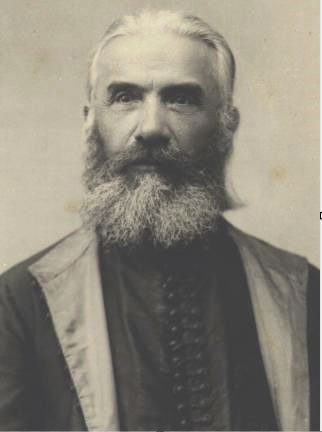
Gheorghe studied at the Romanian gymnasium and high school in Brașov, where he graduated first in his class in 1872. He chose to pursue his medical studies not in Bucharest or Budapest but in Vienna. There, he specialized in balneology under the guidance of Dr. Wilhelm Winternitz (1835–1917). In addition to his medical pursuits, Gheorghe was a gifted violinist and attended the Vienna Conservatory. Furthermore, he was a passionate classical musician and published articles on this subject. Upon returning to Transylvania in 1880, he was appointed as the physician for the Romanian schools in Brașov, and he also served there as a professor of hygiene. He played a crucial role in improving the education of Romanian pupils and enhancing the general health of the people of Brașov. He achieved this by establishing the Baths of the Administration of Romanian Schools, which included medical baths open to all, gaining him recognition in Transylvania and Romania. In 1893, he was appointed as the district physician. His reputation grew significantly, especially after his book Medical Hydrotherapy was published in Bucharest in 1904.
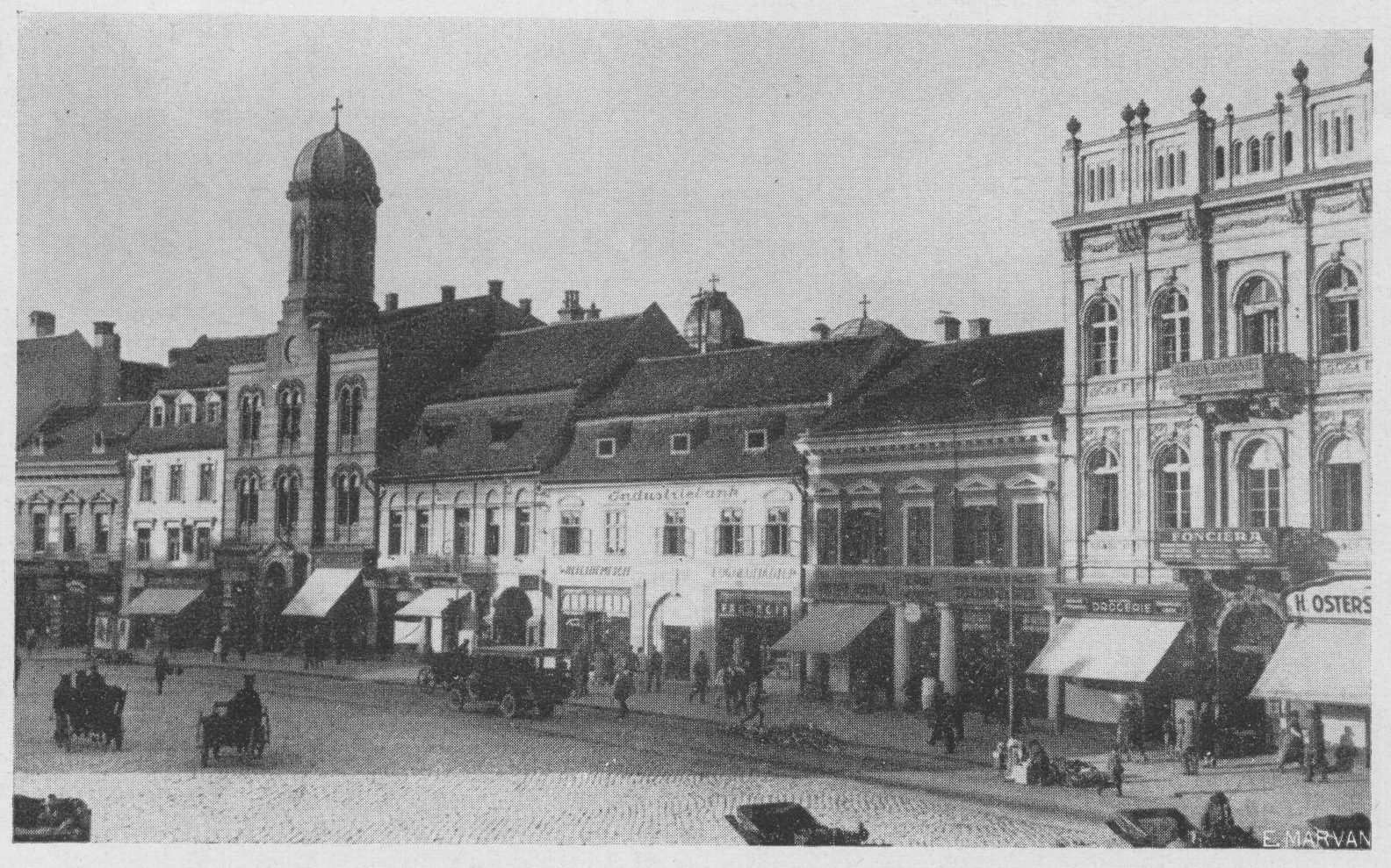
The Council Square in Brașov in the 1920s, România Ilustrată, April 1929
In 1885, he married Maria (?–1929), the daughter of Manole Diamandi, a wealthy merchant, president of the Chamber of Commerce and Industry, a philanthropist, and a politician closely aligned with the Romanian National Party of Transylvania. Manole Diamandi had a strong connection with Romania, not solely due to commercial interests but also because of his generous contributions supporting the War of Independence (1877–1878). It is worth noting that the Baiulescu and Diamandi families were acquainted well before this marriage. Maria, Gheorghe's wife, had a philanthropic role as well. However, it may be challenging to distinguish her activities in the press, as they could easily be confused with those of her sister-in-law, Maria B. Baiulescu.
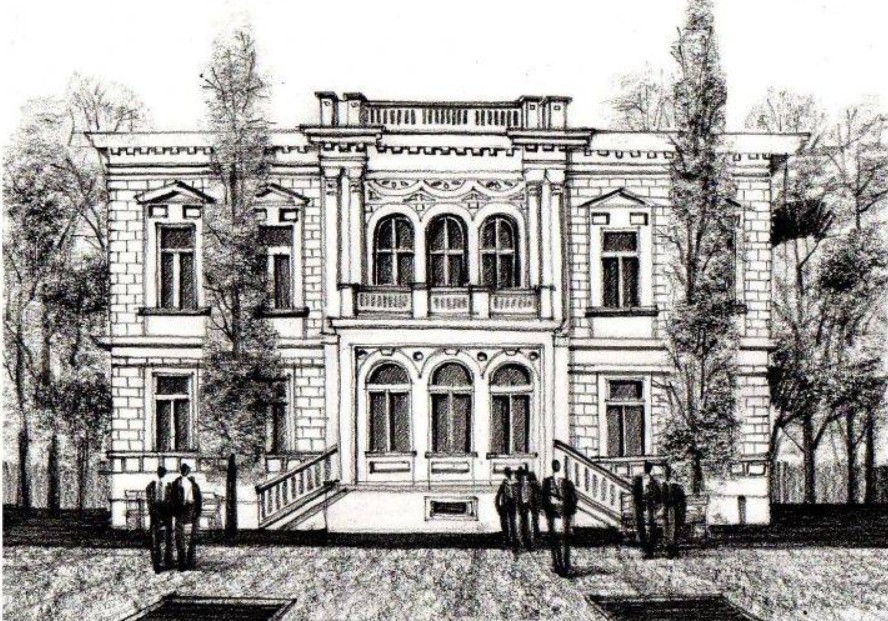
Baiulescu House, a wedding gift from Manole Diamandi, https://www.metropola.ro/ro/ghid/brasov/descopera/turism/muzee/casa-baiulescu-/1637/
An advocate for the national rights of the Romanian minority in Hungary, in August 1916, G. Baiulescu unequivocally supported Romania's entry into World War I against Austria-Hungary. He had connections within the Romanian political elite, particularly with the Liberals, including engineer Ionel I.C. Brătianu (1864–1927), who served as Prime Minister from 1914 to 1918 (and held the office in later terms from 1922 to 1926 and 1927). Ionel Brătianu had been a colleague of Gheorghe's brothers at the Ministry of Public Works. In August 1916, under the Romanian military administration, Gheorghe Baiulescu was appointed as the mayor of Brașov. However, this appointment required him to follow the Romanian troops in retreat a month later. In May 1917, in Moldavia, along with Octavian Goga and Sever Bocu, he co-founded the National Committee of Romanians in Austro-Hungary and served as its president. His political activity aimed to support the Romanians in Transylvania and persuade them to abandon their allegiance to the Habsburg monarchy in favor of the Romanian state. In addition to his political involvement, he had a busy medical career, working in hospitals in Iași, Odessa, and Chișinău/Kishinev (Bessarabia). Due to his medical service, he was promoted to the rank of doctor Lieutenant Colonel.
The former mayor of Brașov became one of the prominent figures of the Transylvania emigrees during World War I and was a political partner of Brătianu. He served as the first prefect of Brașov County, appointed by the Transylvanian Ruling Council in January 1919. He held this position until December 1920, when he was promoted in Bucharest as a general administrative inspector of the Ministry of the Interior. This high-ranking public role was typically occupied by individuals who had demonstrated their organizational capabilities. They retained their office even after changes in the government. As a general administrative inspector, Baiulescu conducted inspections throughout the country, oversaw the prefectures, and advised the minister and the secretary-general of the Ministry of Internal Affairs. On certain occasions, as with Baiulescu, these high-ranking public officials were appointed as acting prefects for counties until a permanent prefect could be assigned, and this interim period could extend for several months. Consequently, Gheorghe Baiulescu served as the acting prefect of Brașov County on three separate occasions (December 1921 – January 1922, February 1923, and July 1923 – January 1924). His close ties to members of the National Liberal Party of the Old Kingdom predate 1916. Still, they became more pronounced after 1922, even though Baiulescu was a tenured prefect under various governments. In fact, in Brașov County, as well as in other Transylvanian counties after 1919, Baiulescu leveraged his influence to influence the appointment of prefects and other dignitaries, often to the benefit of his pre-war or refugee acquaintances.
Baiulescu's social and political involvement in the development of Brașov County was further complemented by his economic interests and various financial investments. He was a member of numerous boards of directors both before and after 1918. Several buildings in Brașov serve as reminders of his legacy: the Baiulescu House, gifted to Gheorghe and Maria by Manole Diamandi (on the present-day Eroilor Boulevard, no. 33) and later donated by the Baiulescu spouses to the city of Brașov, another house that would eventually become one of the headquarters of the local Communist Party (Nicolae Iorga Street, no. 2), and a villa constructed for his family in the 1920s (Nicolae Iorga Street, no. 26). Dr. Baiulescu also played a vital role as the founder and administrator of the Zărnești Cellulose Factory in the 1920s.
Maria and Gheorghe had two sons. Emil (1886–1967) pursued law studies, earning a doctorate in Law and becoming a judge in Brașov. Their second son, Aurel, was likely a law graduate. He served as a reserve cavalry captain. Tragically, his passion for gambling is believed to have led to his suicide via a morphine injection in a hotel room in Brașov in 1932. At the time of his suicide, his brother Emil held the position of president at the Brașov Court of Law.
Gheorghe Baiulescu passed away in 1935. He was interred, alongside other family members, in the cemetery of the Church of Saint Parascheva in Brasov, a church originally founded by his father.
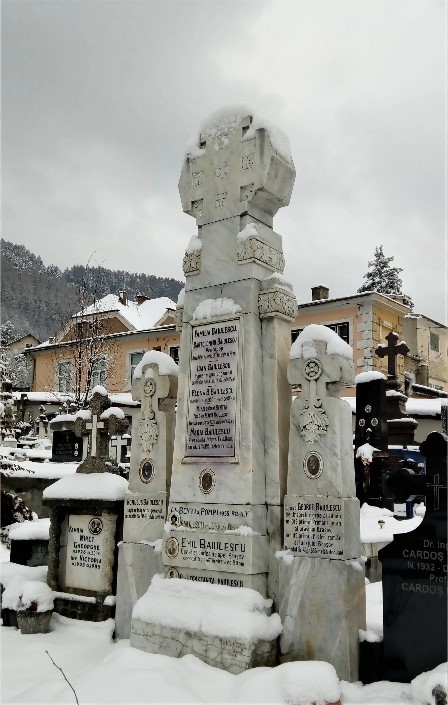
The tomb of the Baiulescu family, the Church of Saint Parascheva cemetery in Brașov, Doctor Gheorghe Baiulescu Street, no. 16, https://scheiibrasovului.wordpress.com/tag/gheorghe-baiulescu/
Bibliography:
Stéphanie Danneberg, “Der Kronstädter Händler Diamandi Manole (1833–1899)”, in Historia Urbana, XXII, 2014, p. 341–353.
“De la înmormântarea inginerului Ioan Baiulescu”, in Gazeta Transilvaniei, LXXII, no. 7, 12 January 1911, p. 3.
Adrian-Horia Enescu, Gabriel-Ion Necula, Prefecți ai județului Brașov de odinioară, 1919-1939, Libris Editorial, Brasov, 2019.
L.N., “O sărbătorire românească la Brașov”, in Adevărul, XLIII, no. 14388, 20 November 1930, p. 2.
“Dr. Med. Gheorghe Baiulescu”, in Gazeta Transilvaniei, an XCIII, no. 120, 16 November, 1930, p. 1–2.
“Sinuciderea tânărului Baiulescu din Brașov”, in Universul, an XLIX, no. 303, 3 November 1932, p. 5.
Petcan, “Dramatica sinucidere a d-rului Baiulescu”, in Dimineața, XXVIII, no. 9288, 3 November 1932, p. 8.


